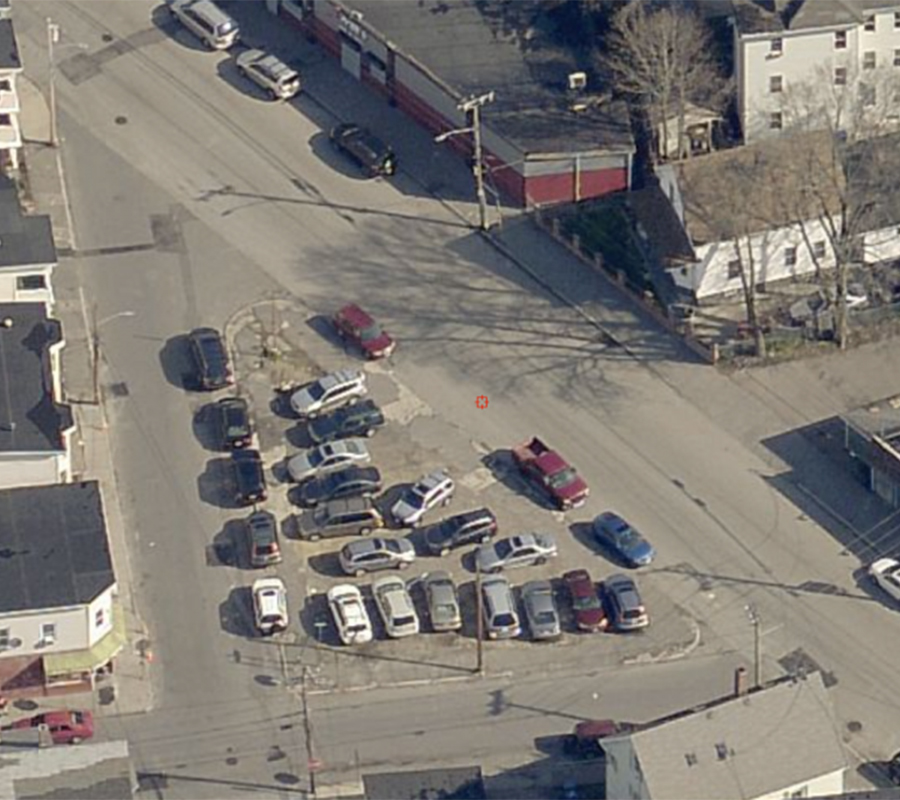Bennington Triangle
The Bennington Triangle is a 3,700 SF brownfield located in the Arlington neighborhood near the Lawrence Street gateway to the city.
Proposed
Formerly used as a fueling station and then as an ad hoc parking lot, the site has been transformed into a popup park with planters around the perimeter and picnic tables in the middle. This tactical activation originated with planning efforts undertaken by Lawrence Pa’lante, Groundwork’s resident task force, which targeted the vacant lot for conversion into a cooling node along the Lawrence Street corridor to reduce urban heat vulnerability.
Engagement with residents in 2022 affirmed Pa’lante’s vision of transforming the site into a neighborhood space. Through a series of meetings residents learned about the contamination at the site and the remedial planning being undertaken by the City of Lawrence. The city had removed five underground fuel storage tanks in 2010, but only recently took steps to address regulatory compliance issues. The site’s soils are contaminated with petroleum, chromium, and gas (1,3-Dichlorobenzene).
This fall the project’s pace will accelerate with the support from the USEPA Multipurpose Brownfield Program. This will support the remedial planning required to design the controls required to ensure the site is safe to become a park. This funding will hopefully be leveraged with additional funding from the Commonwealth of Massachusetts PARC program to construct improvements associated with a community led design process. The goal is for construction to start in the spring of 2025.
This is a partnership project supported by the City of Lawrence, the Merrimack Valley Planning Commission, and the US EPA.

Project Goals
Establish a neighborhood advisory group to help lead the project’s design and implementation.
Cultivate a community vision for a preferred design concept at the Triangle to guide the site’s redevelopment by conducting a series of workshops to create a vision for the space, including educating residents about the site’s recognized environmental constraints and their impact on the space’s design.
Improve access to the Triangle through traffic calming measures designed to make street crossings safer.
Why is this project important to the community?
Groundwork Lawrence has had a strong focus on brownfield remediation because this is a critical need in Lawrence.
The Lawrence and Bennington Triangle is a perfect example of this and the challenges facing the city—contamination, brownfields, vacant lots, limited green space, shade equity, air pollution, and auto congestion. This project is located Arlington neighborhood where residents live in multifamily dwelling units with little to no greenspace. Most of the parcels in the neighborhood are paved over for parking and ease of maintenance, increasing heat vulnerability and compounding poor air quality. Most of the families living near the site spend the warmer months outside congregating on stoops and the sidewalks.
Through the Triangle project, we will provide residents with a meaningful process that develops a plan for how this space will be re-used. Due to the site’s importance as a residential parking hub, creating a neighborhood advisory group to lead efforts will be critical in gaining resident participation, input, and buy-in.
We know through our work in Lawrence and from surveys and community feedback that green space improvements, trail access, pedestrian improvements, and brownfield redevelopment are all important to residents across the city. Despite the project’s small footprint, it has the potential for a significant impact in meeting the needs and wants of the community. Small spaces like the Triangle can provide residents with communal gathering spaces and shaded respite on hot, sunny days.
This project is important to GWL because it builds on work the trust is currently undertaking through the Lawrence Pa’Lante project. Guided by a resident task force, the project is identifying nodes and corridors that can contribute to increasing Lawrence’s climate resiliency. The Lawrence Street corridor and the node at the Triangle are key components of this planning project.
Additionally, with a new administration in Lawrence, GWL is excited to bring resources to priority projects identified by the mayor’s office. The Triangle project helps build strong municipal/non-profit partnerships committed to serving the needs of the City of Lawrence.
